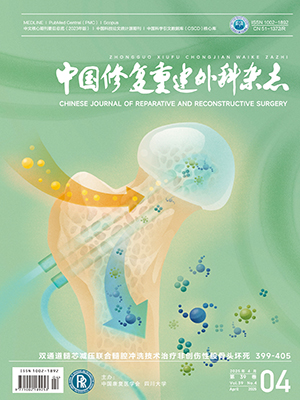| 1. |
王星, 史君, 张少杰, 等. 三维图像测量青少年颈椎钩突的形态特征. 中国组织工程研究与临床康复, 2011, 15(30): 5587-5590.
|
| 2. |
王晓慧, 刘宇, 廉小伟. 颈前路钩椎关节切除术的应用解剖. 解剖学研究, 2008, 30(4): 276-278.
|
| 3. |
凌泽莎. 猕猴椎动脉及横突孔大水的 CTA 观察及其 CSA 模型的可行性研究. 重庆: 重庆医科大学, 2014.
|
| 4. |
瞿东滨, 金大地, 钟世镇. 颈椎钩突的解剖学测量及临床意义. 中国矫形外科杂志, 2002, 9(1): 49-51.
|
| 5. |
鞠晓华, 鞠学红, 王金平, 等. 颈椎钩突的解剖观察及临床意义. 潍坊医学院学报, 2001, 23(3): 164-165.
|
| 6. |
毛雨. 正常人体颈部钩椎关节 X 线研究 (附 40 例 X 线测量). 医学综述, 2008, 14(19): 3029-3030.
|
| 7. |
王星, 史君, 张少杰, 等. 青少年颈椎钩突与横突孔的相关性研究及临床意义. 局解手术学杂志, 2016, 25(10): 728-731.
|
| 8. |
Kocabiyik N, Ercikti N, Tunali S. Morphometric analysis of the uncinate processes of the cervical vertebrae. Folia Morphol (Warsz), 2017, 76(3): 440-445.
|
| 9. |
朱建兵, 龚建平, 钱铭辉. 螺旋 CT 研究颈椎钩突的大小及其相关因素. 颈腰痛杂志, 2006, 27(2): 88-92.
|
| 10. |
Chong E, Pelletier MH, Mobbs RJ, et al. The design evolution of interbody cages in anterior cervical discectomy and fusion: a systematic review. BMC Musculoskelet Disord, 2015, 16: 99.
|
| 11. |
Kwon B, Kim DH, Marvin A, et al. Outcomes following anterior cervical discectomy and fusion: the role of interbody disc height, angulation, and spinous process distance. J Spinal Disord Tech, 2005, 18(4): 304-308.
|
| 12. |
王海波, 王元, 孙璟川, 等. 颈椎前路椎间盘切除融合术术中恢复椎间隙自然高度对术后疗效的影响. 脊柱外科杂志, 2018, 16(5): 284-288.
|
| 13. |
孙超. 单节段 ACDF 的椎间高度矫正程度对邻近节段间盘生物力学影响的研究. 天津: 天津医科大学, 2016.
|
| 14. |
Lu J, Ebraheim NA, Yang H, et al. Anatomic bases for anterior spinal surgery: surgical anatomy of the cervical vertebral body and disc space. Surg Radiol Anat, 1999, 21(4): 235-239.
|
| 15. |
Panjabi MM, Duranceau J, Goel V, et al. Cervical human vertebrae. Quantitative three-dimensional anatomy of the middle and lower regions. Spine (Phila Pa 1976), 1991, 16(8): 861-869.
|
| 16. |
Wilke HJ, Kettler A, Goetz C, et al. Subsidence resulting from simulated postoperative neck movements: an in vitro investigation with a new cervical fusion cage. Spine (Phila Pa 1976), 2000, 25(21): 2762-2770.
|
| 17. |
Ebraheim NA, Lu J, Biyani A, et al. Anatomic considerations for uncovertebral involvement in cervical spondylosis. Clin Orthop Relat Res, 1997, (334): 200-206.
|
| 18. |
袁健东, 陈鑫, 刘彩龙, 等. 颈前路术中钩椎关节切除减压治疗神经根型颈椎病的疗效分析. 中国骨伤, 2012, 25(9): 721-725.
|
| 19. |
韩伟峰, 林欣, 李小光, 等. 颈椎病前路手术减压范围标志的解剖学研究. 中国临床解剖学杂志, 2009, 27(4): 375-378.
|
| 20. |
Lu J, Ebraheim NA, Georgiadis GM, et al. Anatomic considerations of the vertebral artery: implications for anterior decompression of the cervical spine. J Spinal Disord, 1998, 11(3): 233-236.
|
| 21. |
蒋富贵, 瞿东滨, 朱志刚, 等. 颈椎前路减压及内固定的解剖学问题. 中国临床解剖学杂志, 2000, 18(4): 310-311.
|
| 22. |
林永绥, 王万明, 张发惠, 等. 颈椎前路减压手术解剖标志定位测量及其临床意义. 中国临床解剖学杂志, 2014, 32(5): 523-528.
|
| 23. |
杨敏杰, 朱晓白, 刘淼, 等. 经前路切除钩椎关节治疗颈椎病. 西安交通大学学报 (医学版), 1995, 16(2): 192-193.
|
| 24. |
孟庆玲, 施宇云, 谭小翠, 等. Mimics 软件测量颈椎后纵韧带骨化容积. 中国矫形外科杂志, 2018, 26(5): 453-457.
|
| 25. |
孙振辉, 赵成礼, 陈亦飞, 等. 载距突螺钉固定跟骨骨折恒定骨折块的植入方法研究. 中国修复重建外科杂志, 2018, 32(5): 581-586.
|
| 26. |
Loisel F, Chapuy S, Rey PB, et al. Dimensions of the trapezium bone: a cadaver and CT study. Surg Radiol Anat, 2015, 37(7): 787-792.
|




